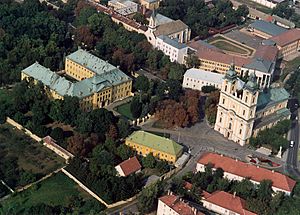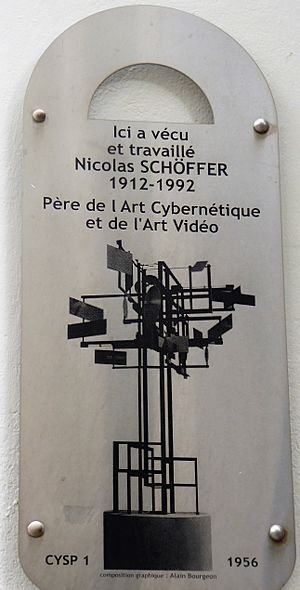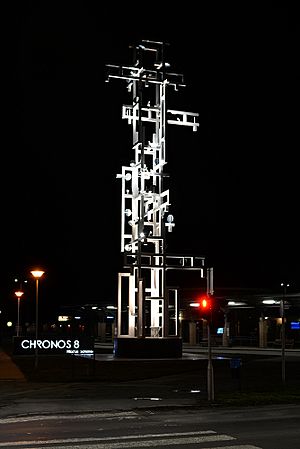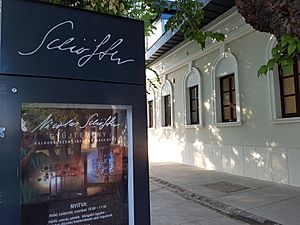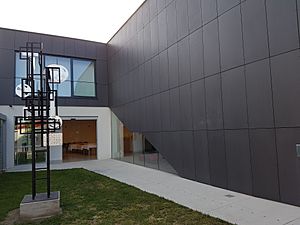Nicolas Schöffer facts for kids
Quick facts for kids
Nicolas Schöffer
|
|
|---|---|
| Schöffer Miklós | |
Nicolas Schöffer Collection Kalocsa
|
|
| Born | 6 September 1912 Kalocsa, Hungary
|
| Died | 8t January 1992 Montmartre, Paris
|
| Education | Royal Hungarian Pázmány Péter University (Budapest), Faculty of Law
Academy of Fine Arts (Budapest) École Nationale Supérieure des Beaux-Arts (Paris) |
| Known for | first cybernetic artwork, painting, graphic, sculpture, architecture, urbanism, video, theatre experiment |
|
Notable work
|
CYS1 cybernetic sculpture
SCAM1 automobile sculpture Plan of a Cybernetic Light Tower for Paris Plan of a cybernetic city KYLDEX1 cybernetic theatre experiment |
| Style | 1. Period: surrealism, impressionism, expressionism
2. Period: kinetic art, cybernetic art, neoplasticism 3. Period: computer graphics |
| Spouse(s) | Marie Rose Marguerite Orlhac Eléonore de Lavandeyra Schöffer |
| Awards | Grand prize for sculpture of the Venice Biennale (1968)
Officer in the Légion d'Honneur (1983) Frank J. Malina Leonardo Award for Lifetime Achievement (1986) Officer in the Ordre des Arts et Lettres (1985) Commander in the Ordre National du Mérite (1990) Order of the Flag of the Republic of Hungary (1990) |
| Elected | member of the French Academy of Fine Arts |
Nicolas Schöffer (Hungarian: Schöffer Miklós; 6 September 1912 — 8 January 1992) was a French artist born in Hungary. He lived in Paris from 1936 until he passed away in Montmartre in 1992.
Schöffer created art based on cybernetics. This is a science about how systems control themselves and use feedback. He used ideas from Norbert Wiener to make art that reacted to its surroundings. His work included painting, sculpture, architecture, and even theatre.
A big goal for Schöffer was to make art available to everyone. He wanted art to be a fun experience that people could be part of. He even explored making art in large numbers, like products in a factory. This way, more people could enjoy it.
Contents
Life and Art Journey
Nicolas Schöffer was born in Kalocsa, a town in southern Hungary. His parents greatly influenced him. His mother was a violinist and taught him music. His father was a lawyer. He encouraged Nicolas to study law, which he did in Budapest.
After studying law, Schöffer also studied art at the Academy of Fine Arts in Hungary. In 1936, he moved to Paris to continue his art studies.
A major event that changed Schöffer's art was the International Exposition of Art and Technology in 1937 in Paris. He became very interested in science and new technologies. This led him to discover Norbert Wiener's book on cybernetics, which completely changed his artistic ideas.
During World War II, Schöffer moved to southern France. After the war, he returned to Paris. He experimented with painting and drawing until he found Wiener's book.
From 1954, Schöffer lived and worked in the Villa des Arts. This place had studios built for artists in 1890. Famous artists like Cézanne and Renoir also worked there. Schöffer had two studios, one of which used to belong to Cézanne.
The 1950s were a big time for Schöffer's art. His work was shown in many important exhibitions. He won the Grand Prize for sculpture at the Venice Biennale in 1968. He became well-known around the world.
In 1982, he became a member of the French Academy of Fine Arts. He received several important awards for his work. In 1986, he had a brain hemorrhage and could no longer move freely. He passed away in 1992. His second wife, Eléonore de Lavandeyra Schöffer, kept his art and ideas alive for many years.
Art Styles and Periods
Schöffer's art career can be split into three main parts. He explored different styles in his early years. Most of his famous works come from his second period. His third period was affected by his illness.
Early Art (1931-1950)
In his early years, Schöffer tried many different art techniques. He learned by imitating famous artists. His art slowly changed from realistic pictures to abstract shapes. He moved from flat paintings to creating art that came out into space, like reliefs. These reliefs were like sculptures that were still attached to a flat surface.
He used simple shapes like squares and circles, and basic colors like red, yellow, blue, plus black, white, and gray. These ideas were similar to Mondrian's Neoplasticism style. Later, his reliefs became freestanding sculptures, moving into his next art period.
Main Art Period (1950-1986)
This was when Schöffer created his most important works. He wanted to make art quickly and automatically. He used cybernetics to help with this. He often worked with a team, sometimes even letting a computer program create parts of the art. He also wanted people to interact with his art and change it themselves.
He imagined a "cybernetic city" where art was everywhere and helped organize how the city worked.
Spatiodynamism (1950-1957)
Schöffer started making sculptures that looked good from every angle, not just one main view. He focused on the empty space around and within the sculpture. He used steel parts with rectangular and circular plates. These sculptures were mostly still, but they made viewers think about space and movement as they walked around them.
Luminodynamism (1957-1959)
In this period, Schöffer added light to his sculptures. He used colored and white lights to shine on his creations. The shadows created on the walls were also part of the artwork. He even used a special screen to make the art look different from various angles. These works were very dynamic and looked amazing when filmed. Schöffer made short films of them, like early music videos.
Chronodynamism (1959-)
The Microtemps series were small boxes with moving parts inside. These parts spun so fast that they challenged how quickly our eyes and brains could see them. The Luminos were similar and were some of the first artworks made in large numbers for people to buy.
These works led to Chronodynamism, where Schöffer focused on time. He created sculptures using cybernetics that could make endless new patterns, never repeating the same way.
His works grew bigger, like the Chronos series of cybernetic light towers. These towers can be found in different cities. Chronos 8 is in his hometown of Kalocsa. He even planned a huge cybernetic light tower for Paris, which would have been taller than the Eiffel Tower. It was meant to be an information center and a work of art for the city. Sadly, it was never built.
Later Ideas of the Second Period
Schöffer planned many more cybernetic sculptures and fountains. He wanted to make art part of everyday city life.
- Les Tour Soleil (Sun Towers) would have used solar energy to power lights and motors at night.
- Les Basculantes (Tumbling Sculptures) were cybernetic sculptures that would constantly tilt in different directions.
- Hydro-Thermo-Chronos Fountains would have used water, fire, and lasers to create huge shows with loud sounds.
- Les Percussonor (1984–85) were interactive artworks. People could hit parts of them to make sounds and relieve stress.
Many of these ideas were never fully built during his lifetime. However, some, like LUX 10, were built decades later in places like South Korea. Some of his lost or unbuilt works have even been recreated digitally for films.
Final Art Period
After his brain hemorrhage, Schöffer's right side was paralyzed. He could no longer work on big projects. In this last period, he created graphic art using his left hand or a computer. This period combined ideas from his whole career, showing his continued creativity even with his illness.
Important Works
CYSP1
In 1956, Schöffer created CYSP1, the first cybernetic sculpture in art history. Its name comes from "cybernetic" and "spatiodynamic." This sculpture could move on its own and had 16 plates that turned. It had an "electronic brain" with sensors that reacted to changes in light, color, and sound.
CYSP1 was first shown in Paris. It even performed with dancers from Maurice Béjart's ballet company in Marseille. The sculpture reacted to the dancers' movements, creating a unique show.
SCAM1
SCAM1 was the first car sculpture in art history. Most sculptures stay in one place, but SCAM1 was different. This tall sculpture (3.93 meters high) was put on a special car. It could travel around cities like Milan and Paris in 1973, drawing a lot of attention. Sadly, SCAM1 no longer exists because it was difficult to park and store.
TLC Paris (Cybernetic Light Tower for Paris)
Schöffer created many light towers in cities around the world. The first one was built in Biot, France, in 1950. A 50-meter-tall tower was built near Paris in 1954, with sounds created by Pierre Henry. These early towers were taken down after the exhibitions.
The tallest tower built so far is 52 meters high in Liège, Belgium (1961). Other towers were built in Washington D.C., Montevideo, San Francisco, Bonn, Munich, and his hometown of Kalocsa.
These towers are seen as sculptures or "architectural sculptures." They show the power of human ideas and interact with their surroundings. Schöffer saw them as symbols of the Universe.
The Cybernetic Light Tower he planned for Paris was much bigger. It would have been 324 to 347 meters tall, taller than the Eiffel Tower. It was designed as a building people could enter, with restaurants, concert halls, and observation decks. It would have been an information center, art space, and weather tower all in one.
Many big French companies worked on the plans. It would have had thousands of mirrors, lights, and sensors. Important people like President Charles de Gaulle and Georges Pompidou supported the project. However, it was never built because Pompidou died and there were economic problems. It is still considered Schöffer's greatest idea.
Voom Voom
Voom Voom was one of the first discos with a light show, like the nightclubs we have today. It was built in Saint-Tropez and was a kind of test for the entertainment areas in his cybernetic city. The inside was designed by Schöffer, with mirrors and light walls controlled by an "electronic brain." It was so popular that another Voom Voom disco was built.
Famous actress Brigitte Bardot often visited the Saint-Tropez disco. Some of the first video clips were filmed there with her, featuring Schöffer's light show.
Cybernetic City
In 1965, Schöffer helped start a group called the International Group for Prospective Architecture. They believed that old city designs didn't fit modern life anymore. They thought that fast changes in technology, population, and free time meant cities needed new plans.
This inspired Schöffer to design his "cybernetic city." Like Le Corbusier who designed the city of Chandigarh from scratch, Schöffer started his city plan from zero.
His city had three main parts: one for work, one for homes, and one for fun. These parts were connected and controlled by a central cybernetic system. Schöffer also talked about a "soft city" and a "hard city," similar to computer software and hardware.
Schöffer believed art should be the most important part of city planning. He thought that good design and function went hand-in-hand. He focused on "immaterial factors" like electricity and electronics. He wanted to shape space, time, light, sound, and climate.
In Schöffer's city, cybernetics meant that the majority of people could quickly make their wishes happen. He designed a vertical city for work with tall buildings and wide-open spaces. The residential areas were horizontal, with long apartment blocks. He imagined cars and goods moving underground.
He thought people would have more free time because of automation. So, his city had many places for fun and relaxation, including a special "Spatiodynamic Theatre." This theatre would have continuous shows that changed based on the audience's reactions.
House with Invisible Partitions
Schöffer also thought about how climate affects buildings. He designed a house in 1957 called the "House with Invisible Partitions." It was an experiment to create different climates in the same room without any walls.
The house had a round part and a trapezoidal part. In the round part, it was hot (35-40°C), very bright, and noisy, with red and orange colors. In the trapezoidal part, it was cool (18-20°C), quiet, and dimly lit with blue colors. There were no physical walls between these opposite spaces.
Visitors were amazed when they stepped from one part to the other and felt such a big change. This "magic" was done using special wall materials for insulation and soundproofing, careful air conditioning, and special lighting. For example, infrared curtains created local heat, and blue lights made the cool part feel even cooler.
KYLDEX1
Schöffer often worked on theatre projects. His sculpture CYSP1 appeared on stage many times. He designed sets for plays and fashion shows, like a Paco Rabanne fashion show in 1967.
In his cybernetic theatre, robots and light effects were on stage. Their actions were controlled by cybernetic principles, sometimes even reacting to chance. In the play KYLDEX1, the audience could actually control the show!
KYLDEX1 (KYbernetic and LuminoDynamic theater EXperiment) was shown in 1973 at the Hamburg State Opera. The audience's heartbeats were measured and used as input for the show. People in the audience also had color cards to vote. The majority's decision could change the show's speed, repeat parts, or even stop it. This made the audience part of the performance.
Schöffer Collection in Kalocsa
Nicolas Schöffer moved to Paris in 1936 but returned to his hometown of Kalocsa, Hungary, in 1976. In 1979, he gave a collection of his artworks to the city. A museum was opened in his birth house the next year.
In 2015, the museum was completely rebuilt to modern standards. It now helps teach schoolchildren about art. Temporary exhibitions and international conferences are held there.
Nicolas Schöffer's Books
Schöffer wrote ten books explaining his ideas about art, architecture, and city planning.
His first book, Le Spatiodynamisme (1955), explained his idea of "spatiodynamism." It talked about how sculptures interact with space and how the sculptor's role changed. He even created a new science called "plasticosociology" to study how art in cities affects people's behavior.
His books La Ville Cybernétique (1972) and La nouvelle charte de la ville shared his ideas for the city of the future. Le nouvel esprit artistique contained his thoughts on his mature theories of spatiodynamics, luminodynamics, and chronodynamics.
The book La Tour Lumière Cybernétique described his huge cybernetic light tower planned for Paris. In Perturbation et chronocratie, he explored how cybernetics could help people deal with stress in modern life.
In his last book, Surface et Espace, published during his lifetime, Schöffer looked back at his work. It included drawings and computer-generated images from his final creative period.
He also wrote an essay called Sonic and Visual Structures: Theory and Experiment for the Leonardo journal in 1985. In it, he shared his views on music and its role in society.
Writings about Schöffer
Many books and studies have been written about Nicolas Schöffer. The first book about him was published in 1963. It included essays and even a vinyl record of music by Pierre Henry. Another book was published in 2004.
Many university papers have also explored his art from different angles. Some focused on his early works, others on how he moved from single artworks to planning entire cities. Some even digitally recreated his lost or unbuilt works in 3D.
See also
 In Spanish: Nicolas Schöffer para niños
In Spanish: Nicolas Schöffer para niños


